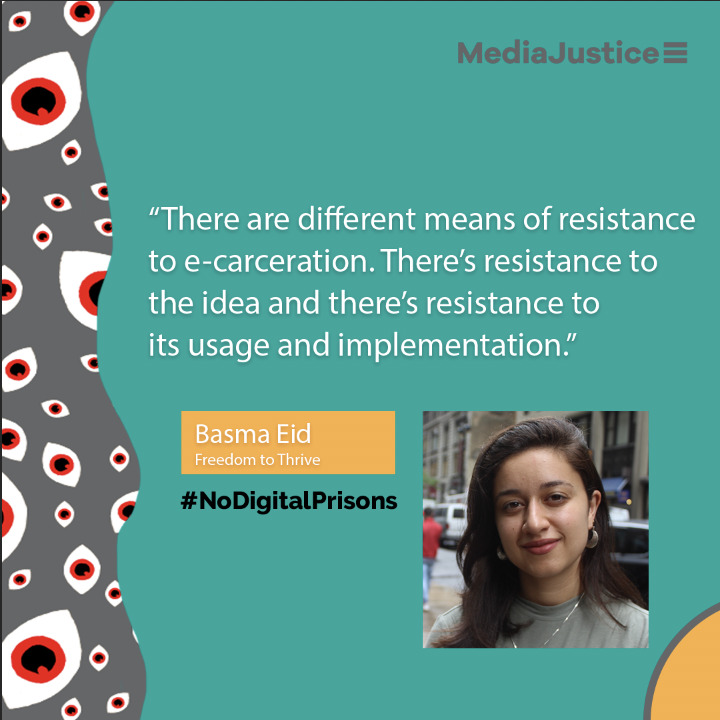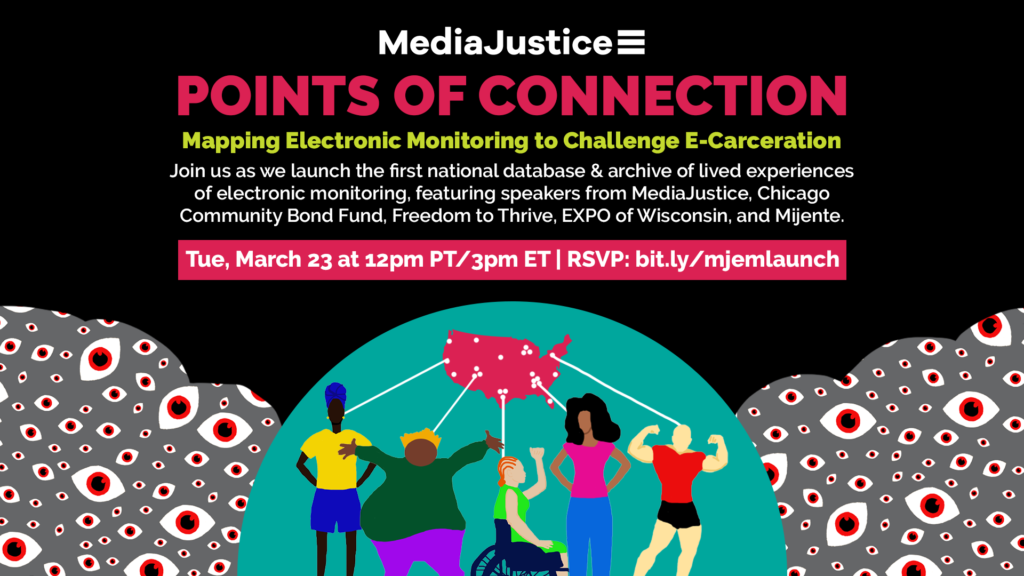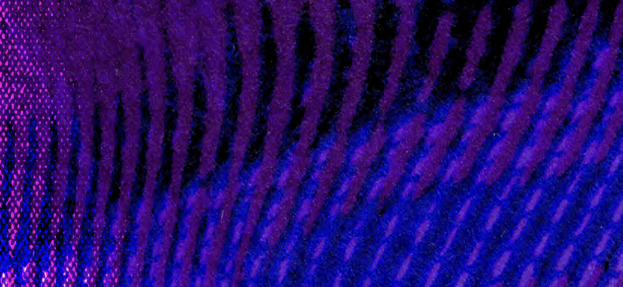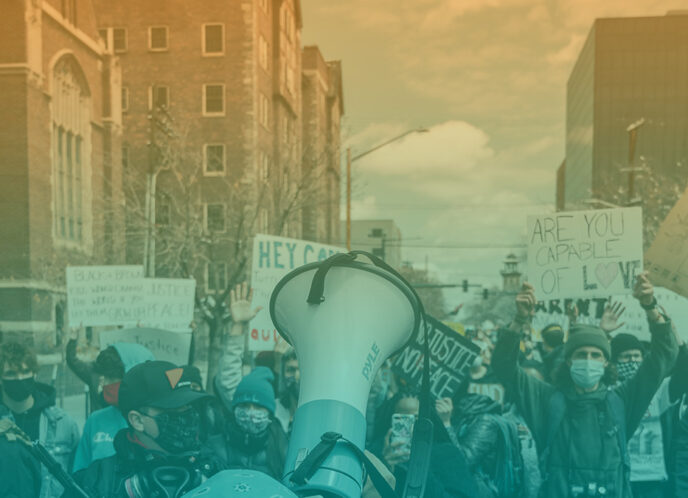
1. How do you define e-carceration?
Basma Eid, National Programs Manager at Freedom to Thrive: The term “e-carceration” reflects our E-World — increasingly more of our day to day lives and the systems that control us are within the “E” realm. The term helps us understand the many ways technology is deployed as a tool for the state (and corporations) to surveil, incarcerate, and control people. E-carceration encompasses the multiple modes of digital and electronic supervision, ranging from social media surveillance to electronic monitoring.
2. Why is e-carceration particularly a problem for Black and brown migrant communities?
Basma: E-carceration is often touted by criminal “justice” reformers’ (normalizers) as an alternative solution to mass incarceration, which we know disproportionately impacts poor and working class, Black and brown communities. The same is true within the context of the pernicious immigration and crimmigration systems where it’s those same communities who are disproportionately targeted by these racist systems. E-carceration, like mass incarceration, doesn’t start when someone has an ankle shackle forced to their body. It begins with the ways Black and brown communities are policed and surveilled. Immigrant neighborhoods and communities have a higher presence of U.S. Immigration and Customs Enforcement (ICE) activity while white, upper-class immigrants are more easily able to receive visas to immigrate. It’s important to understand the how policies and laws, are enforced through racists and xenophobic lenses.
For asylum seekers, migrants, and refugees who are incarcerated in immigration jails across the U.S., e-carceration presents itself as sometimes the only means of getting out of detention. But the reality is that once folks are on the other side, their lives continue to be under constant surveillance. Often, the conditions of a person’s release are unclear and judges arbitrarily determine who has to wear an ankle shackle.
Only after decades of diligent organizing demanding the abolition of prisons have the evils of mass incarceration become exposed to the mainstream. There is general bi-partisan agreement that the prison industrial complex is a bad thing, but the solutions put forth by policy makers and reformers are as good as putting a wolf in sheep’s clothing.
E-carceration is not a solution to the problem of mass incarceration, the only solution is liberation and the abolition of the system.
3. Can you share a story of community members who have experienced e-carceration?
Basma: Many of the folks we interviewed about their experiences on an ankle monitor spoke about multiple ways being e-carcerated negatively impacted them and their families, including physical pain due to the shackle, stigmatization, technical difficulties with the device (battery malfunctioning, not charging etc.) that resulted in immigration officers showing up at their home, calls from Intensive Supervision Appearance Program (ISAP) in the middle of the night, harassment, and being unable to visit family and friends for fear that they could put their communities at risk.
Here are some of our community members’ stories of e-carceration:
Rosanna (alias) on the stigma she experienced while on a monitor:
“The first time I moved here and went out to a grocery store, the device was visible and [I noticed] people were staring. A woman was talking about me. I learned she was speaking about me when someone intervened and told her to leave me alone. I asked the intervener what that woman was saying about me, and they responded that she was saying I was a criminal because of my device. I felt frustrated and started to cry because I felt like a criminal. I tried not to leave my house and if I had to leave, I would cover the monitor because I didn’t want people to think or say I’m a criminal. I wore loose clothes so no one could see my device. This device also didn’t allow me to work which was really frustrating. But like I always say God gives people the strength to get through things. I prefer them to put this on me than my son.”
Jose (alias) on how the ankle shackle prevented him from working and created issues for him while taking English language classes:
“I have had the device for a little over 10 months. When I was bailed out, I found out I would be placed on a monitor but, for me, the most important thing was to leave prison. It was horrible in the prison, and I wanted to get out. I signed, but I also didn’t have a choice, even though $30K was paid for my release. I have been told that this is a tactic used by ICE. They don’t give you a choice. When you leave prison, they give you a monitor. They want to tire you out. They want you to continue suffering until you are fed up and take it off. Then, they come and deport you and keep all the money from this business. The entire $30K is gone, and all the other money they got is gone. The companies keep it.”
““The monitor is not necessary. I don’t understand why some people get it and others don’t. They also never give a reason. They should not do this at all. I’m experiencing an extremely unjust situation. My bail was set high and then I also had to wear the monitor. Detaining people is not just because these are people who are fleeing from their country, and when you deport them they will be killed. I have heard about a lot of people being deported and then killed.”
These are just two experiences, there are thousands of individuals who are experiencing the negative consequences of electronic monitoring.
4. How can we resist e-carceration? What examples have you seen of effective organizing against e-carceration?
Basma: There are different means of resistance to e-carceration. There is resistance to the idea and resistance to its usage and implementation.
Part of the resistance to the idea of e-carceration has been centered around the “battle of the story” — the ways the false alternative that e-carceration represents has been deconstructed and attacked. Thought leaders and movement leaders like Michelle Alexander who have written about the expansion of e-carceration are crucial for bringing e-carceration into the consciousness of the mainstream.
The research that organizations like American Friends Service Committee (AFSC) and Grassroots Leadership have done around the “treatment industrial complex” is a good example of the research that’s needed to expose for-profit prison companies like the GEO Group who have expanded their means of control through the acquisition of BI Incorporated.
At Freedom to Thrive, we have focused on increasing political education and awareness about e-carceration. Our Not On Our Watch poster was one step towards educating our community about this threat.
Bail reform campaigns, like in Illinois, are important examples to consider when thinking about organizing around e-carceration abolition. Efforts to eliminate and limit the use of ankle shackles pre-trial should be central to any conversation around bail reform. However, as we have seen across the country, and particularly in New York, bail reform victories have been short lived as demands are hacked away by electeds and eventually reneged and/or put on hold.
There is a lot of work that still needs to be done around ending e-carceration and many possibilities for potential campaigns both in the criminal legal and crimmigration systems. E-carceration is not necessarily a widely understood term so there is more work to be done around messaging. When you explain e-carceration, folks are familiar with technology like ankle monitors or facial recognition but they may not make the direct connection to e-carceration. We have to expand our focus on not only ankle monitors but the wider web of surveillance. This continues to be a challenge. There’s a lot of organizing around resistance to surveillance, like the facial recognition ban in Portland and in other cities, but those wins must also be framed within the context and framing of e-carceration.
MediaJustice’s Challenging E-Carceration project has been researching trends involving electronic monitoring (EM) and other punitive technologies for several years. We are presenting our findings at the launch of our EM hotspots map on Tuesday, March 23 at 3pm EST. Register today: https://p2a.co/2JNYNh0




